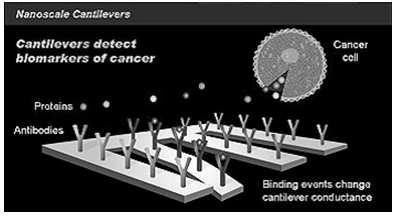About Authors: Rinki Verma,
Research fellow,
Banaras Hindu University, Varanasi-221005
Abstract
Cancer is caused by damage of genes which control the growth and division of cells. Detection/diagnose/treatment is possible by confirming the growth of the cells and treated by rectifying the damaging mechanism of the genes or by stopping the blood supply to the cells or by destroying it. Conventional detection method of the cancer is not more efficient than nanotechnogical detection method. Nano Particles (NP) being of a few of nano meters size and the cells being of the size of few microns, NP can enter inside the cells and can access the DNA molecules/Genes and therefore, there is a possibility that the defect in the genes can be detected. The conventional treatment is less sensitive than the nanotechnology methods, certain NP can be designed to absorb preferentially certain wave length of radiation and if they enters in the cancerous cells, they will burn them So, Nanotechnology can be used to create therapeutic agents that target specific cells and deliver toxin to kill them.
Reference ID: PHARMATUTOR-ART-1091
Background
Cancer is a complicated disorder characterized when the cells can familiarity uncontrolled growth if there are damages or mutations to DNA, and therefore, damage to the genes involved in cell division. On the basis of molecular study there are four types of gene are responsible for the cell division process: 1) onco-genes cells when to divide, 2) tumor suppressor genes cells when not to divide, 3) suicide genes control apoptosis and last 4) cell to kill itself if something goes erroneous, and DNA-repair genes instruct a cell to repair damaged DNA. Due to uncontrolled cell division cancerous cell to form lumps or masses of tissue it is well known TUMORS, except in the case of Leukaemia. Tumour can grow rapidly which interfere with the digestive, nervous, circulatory and hormonal system by the altered of the body metabolism system but that stay in one spot and demonstrate limited growth are generally considered to be benign.
Cancer is ultimately the result of cells that uncontrollably grow and do not die. Normal cells in the body follow an orderly path of growth, division, and death. Programmed cell death is called apoptosis, and when this process breaks down, cancer begins to form. Unlike regular cells, cancer cells do not occurrence programmatic death and instead continue to grow and divide. This leads to a mass of abnormal cells that grows out of control. There are various factor involved in the breaking of normal apoptosis pathway: some are 1) Carcinogens ( substances that are directly responsible for damaging DNA, promoting or aiding cancer), Tobacco, asbestos, arsenic, radiation such as gamma and x-rays, the sun, and compounds in car exhaust fumes are all examples of carcinogens. When our bodies are exposed to carcinogens, free radicals are formed that try to steal electrons from other molecules in the body. Theses free radicals damage cells and affect their ability to function normally. 2) Cancer are inheritable disorder that may be a possibility to transmitted from parental generation to offspring so, it is occur due to a genetic mutations or a blemish in a gene that makes one statistically more likely to develop cancer later in life. 3) One is most prominent risk factor age, there is an increase in the number of possible cancer-causing mutations in our DNA. 4) Biological agents : there are several viruses have also been linked to cancer such as: human papillomavirus (a cause of cervical cancer), hepatitis B and C (causes of liver cancer), and Epstein-Barr virus (a cause of some childhood cancers). Human immunodeficiency virus (HIV) - and anything else that suppresses or weakens the immune system - inhibits the body's ability to fight infections and increases the chance of developing cancer.
There are five broad groups that are used to classify cancer.
1. Carcinomas are characterized by cells that cover internal and external parts of the body such as lung, breast, and colon cancer.
2. Sarcomas are characterized by cells that are located in bone, cartilage, fat, connective tissue, muscle, and other supportive tissues.
3. Lymphomas are cancers that begin in the lymph nodes and immune system tissues.
4. Leukemias are cancers that begin in the bone marrow and often accumulate in the bloodstream.
5. Adenomas are cancers that arise in the thyroid, the pituitary gland, the adrenal gland, and other glandular tissues.
In the advance medical field there is no single treatment or management for cancer, but all treatment are depened on the some factor such as age of patients, stage and types of cancer etc. There are combination of therapies and palliative care. Treatments usually fall into one of the following categories: surgery, radiation, chemotherapy, immunotherapy, hormone therapy, or gene therapy but now a modern era of medical area, researcher developed most effective and advance sophisticated technology with advance knowledge: Nanotechnology.
Introduction
Nanotechnology
The theme of nanotechnology is the control of material on a scale of 1 to 100 nanometres and fabricates the devices on this scale of length. On nano scale, there is greatly increase in ratio of surface area to volume. Due to this, materials at nano scale show very different properties compared to what they exhibit on a micro scale, enabling unique applications.
• For instance,
• opaque substances become transparent(copper),
• inert material becomes catalysts (platinum),
• stable material turn combustible (aluminium),
• solids turns into liquids at room temperature (gold),
• insulator become conductors (silicon).
NOW YOU CAN ALSO PUBLISH YOUR ARTICLE ONLINE.
SUBMIT YOUR ARTICLE/PROJECT AT articles@pharmatutor.org
Subscribe to Pharmatutor Job Alerts by Email
A material such as gold which is inert can become potent chemical catalyst at nano scale. Some of the unique applications of nano materials include, a) titanium dioxide nanoparticles in Cancer can be cured by rectifying the damaging mechanism of the genes or by stopping the blood supply to the cells or by destroying it. Detection/diagnose is possible by confirming the growth of the cells, Sunscreen, cosmetics and some food products, b) silver nanoparticles in food packing, clothing, disinfectants and house-hold appliances. C) zinc oxide nanoparticles in cosmetics, surface coatings, paints and outdoor furniture varnishes. However, further applications require actual manipulations or arrangement of nanoscale components await further research.
One nanometer (nm) is one billionth, or 10–9 of a meter. For comparison, typical carbon-carbon bond lengths, or the spacing between these atoms in a molecule, are in the range 0.12 - 0.15 nm, and a DNA double helix has a diameter around 2 nm. On the other hand, the smallest cellular life forms, the bacteria of the genus Mycoplasma, are around 200 nm in length. Many of the cells are of the dimensions of micro meter. This provides the possibility of nanoparticles entering the cells and detect/treat the molecular changes that occur due to cancerous causes, in small percentage of cells. Therefore, the necessary tools must be extremely sensitive. Scientists and researchers hope that nanotechnology can be used to create therapeutic agents that target specific cells and deliver the toxin in a controlled, time-release manner. The basic aim is to create single agents that are able to both detect cancer and deliver treatment. The nanoparticles will circulate through the body, detect cancer-associated molecular changes, assist with imaging release a therapeutic agent and then monitor the effectiveness of the intervention.
Detection Of cancerous cell: There are various conventional technique which are apply for detection of uncontrolled growth of cell or cell division However the limitation of this method is that it is not very sensitive and the detection is possible only after substantial growth of the cancerous cells. Often the treatment is also not possible once the cancer is in such an advanced stage. Detection of cancerous cell can be accurately done by used of modified material or particles formed through Nanotechnology, is well know nanoparticles (NP) are of a few of nm and the cells are of the size of few microns. So NP can enter inside the cells and can access the DNA molecules/Genes and, there is a possibility that the defect in the genes can be detected. DNA molecules can be detected in their embryonic stage and also it is shows potential in vivo or in vitro.
Treatment of cancer:
One of the most useful conventional treatments is Surgery. However, the limitation is that one loses the organ and the cancer may appear again. In the modern era, nanotechnology developed some certain nano particles can be designed to absorb preferentially certain wave length of radiation and gets heated. Such a NP if enters in the cancerous cell will burn it if irradiated by suitable wavelength radiation. This is kind of the analogue of radiation therapy. It ii well known phenomena, Nanotechnology can be used to create therapeutic agents that target specific cells and deliver toxin to kill them. The NP will circulate through the body, detect cancer associated molecular changes, assist with imaging release a therapeutic agent and then monitor the effectiveness of the intervention. Nanotechnology are completed and more effective when used some different TOOL - TECNIQUE for detection and treatment cancer cell such as 1. Cantilevers (fig.a),

Fig a: Represent Mechanism of Cantilevers to treatment of cancer cell. (Source: National Cancer Institute, USA)
2. Nanopores, 3. Dendrimer, 4.Nanotubes (NT), 5. Quantum dotes (QD), and 6.Nanoshelle(NS).
These all types of Nanoparticles involved with a general pathway to recognizes cancer cells, and enter with specific toxin in the cell to kill those cells and a molecule that recognizes the signals of cell death or follow the pathway of programmed cell death.
The technologies mentioned above are in the various stages of discovery and development. Some of the technologies like quantum dots, nano pores and other devices may be available for detection and diagnosis and for clinical use within next ten years.
Important Properties of advance Challenging technology “Nanotechnology”:
A) Quantum dots are so powerful tools used for simultaneous imaging of multiple proteins, the minute differences in the subcellular niche of these two proteins in normal and cancer cells has been visualized.
B) Carbon Nano Tubes (CNT) have a novel and useful properties and their manufacturing will increase. The available knowledge indicates that CNT may have unusual toxicity properties.
C) Chitosom nanoparticles with enccapslated quantum dots have been synthesized and used to deliver of HERZ SiRNA. Using such a construct, the delivery and transfection of the SiRNA can be monitored by the presence of fluorescent QDs in the Chitosan NPs. Targeted delivery of HERZ SiRNA to HER2 – over expressing SKBR3 breast cancer cells has been shown to be specific with chetosen/QD NP surface labled with HERz antibody targeting the HERz receptors on SkBR3 cells. Gene silencing effects of the conjugated SiRNA has also been established using the luciferase and HER2ELISA assays. These self tracking SiRNA delivery NP will aid in the monitoring of future gene silencing studies in vivo.
Summary:
Nanotechnology has large potential in detection and treatment of cancer in its embryonic stage.
The potential arises due to the ability of NP entering inside the cells and access to the chromosomes/FNA molecules.
Certain nano structures like nanocantilevers, nanopores, nanotubes, nanoshells and quantum dotes are prospective structures that would help in detecting and treatment of cancers.
Dendrimers are to serve detection, treatment and signaling that the cells are killed.
Still there are many challenges that are to be met before use of NT becomes a reality.
Toxicity of the NP is an issue that is to be resolved through legislative and regulatory means.
Acknowledgment:
Dr. A. K. Saxena
NOW YOU CAN ALSO PUBLISH YOUR ARTICLE ONLINE.
SUBMIT YOUR ARTICLE/PROJECT AT articles@pharmatutor.org









